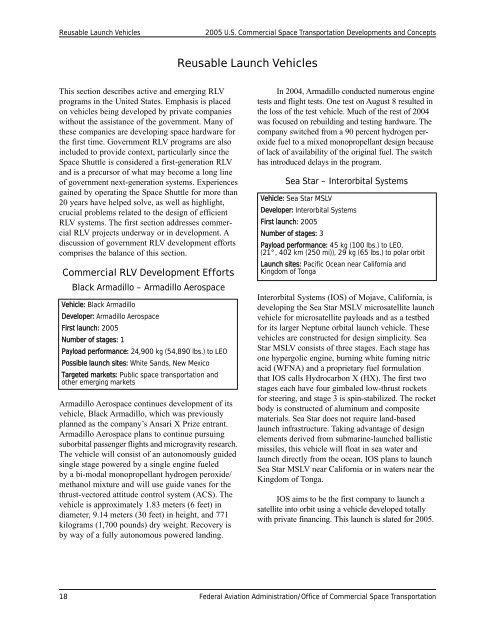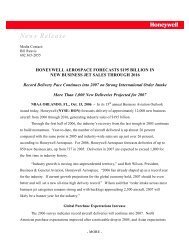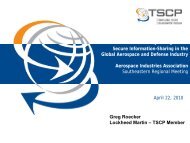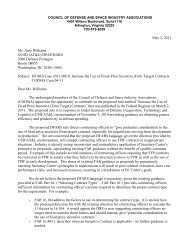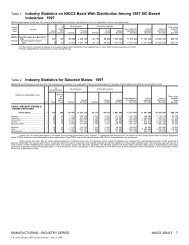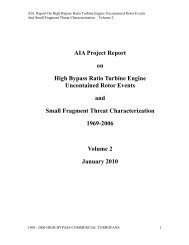Untitled - Aerospace Industries Association
Untitled - Aerospace Industries Association
Untitled - Aerospace Industries Association
You also want an ePaper? Increase the reach of your titles
YUMPU automatically turns print PDFs into web optimized ePapers that Google loves.
Reusable Launch Vehicles2005 U.S. Commercial Space Transportation Developments and ConceptsReusable Launch VehiclesThis section describes active and emerging RLVprograms in the United States. Emphasis is placedon vehicles being developed by private companieswithout the assistance of the government. Many ofthese companies are developing space hardware forthe first time. Government RLV programs are alsoincluded to provide context, particularly since theSpace Shuttle is considered a first-generation RLVand is a precursor of what may become a long lineof government next-generation systems. Experiencesgained by operating the Space Shuttle for more than20 years have helped solve, as well as highlight,crucial problems related to the design of efficientRLV systems. The first section addresses commercialRLV projects underway or in development. Adiscussion of government RLV development effortscomprises the balance of this section.Commercial RLV Development EffortsBlack Armadillo – Armadillo <strong>Aerospace</strong>Vehicle: Black ArmadilloDeveloper: Armadillo <strong>Aerospace</strong>First launch: 2005Number of stages: 1Payload performance: 24,900 kg (54,890 lbs.) to LEOPossible launch sites: White Sands, New MexicoTargeted markets: Public space transportation andother emerging marketsArmadillo <strong>Aerospace</strong> continues development of itsvehicle, Black Armadillo, which was previouslyplanned as the company’s Ansari X Prize entrant.Armadillo <strong>Aerospace</strong> plans to continue pursuingsuborbital passenger flights and microgravity research.The vehicle will consist of an autonomously guidedsingle stage powered by a single engine fueledby a bi-modal monopropellant hydrogen peroxide/methanol mixture and will use guide vanes for thethrust-vectored attitude control system (ACS). Thevehicle is approximately 1.83 meters (6 feet) indiameter, 9.14 meters (30 feet) in height, and 771kilograms (1,700 pounds) dry weight. Recovery isby way of a fully autonomous powered landing.In 2004, Armadillo conducted numerous enginetests and flight tests. One test on August 8 resulted inthe loss of the test vehicle. Much of the rest of 2004was focused on rebuilding and testing hardware. Thecompany switched from a 90 percent hydrogen peroxidefuel to a mixed monopropellant design becauseof lack of availability of the original fuel. The switchhas introduced delays in the program.Sea Star – Interorbital SystemsVehicle: Sea Star MSLVDeveloper: Interorbital SystemsFirst launch: 2005Number of stages: 3Payload performance: 45 kg (100 lbs.) to LEO,(21°, 402 km (250 mi)), 29 kg (65 lbs.) to polar orbitLaunch sites: Pacific Ocean near California andKingdom of TongaInterorbital Systems (IOS) of Mojave, California, isdeveloping the Sea Star MSLV microsatellite launchvehicle for microsatellite payloads and as a testbedfor its larger Neptune orbital launch vehicle. Thesevehicles are constructed for design simplicity. SeaStar MSLV consists of three stages. Each stage hasone hypergolic engine, burning white fuming nitricacid (WFNA) and a proprietary fuel formulationthat IOS calls Hydrocarbon X (HX). The first twostages each have four gimbaled low-thrust rocketsfor steering, and stage 3 is spin-stabilized. The rocketbody is constructed of aluminum and compositematerials. Sea Star does not require land-basedlaunch infrastructure. Taking advantage of designelements derived from submarine-launched ballisticmissiles, this vehicle will float in sea water andlaunch directly from the ocean. IOS plans to launchSea Star MSLV near California or in waters near theKingdom of Tonga.IOS aims to be the first company to launch asatellite into orbit using a vehicle developed totallywith private financing. This launch is slated for 2005.18 Federal Aviation Administration/Office of Commercial Space Transportation


